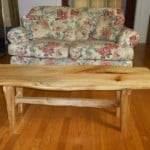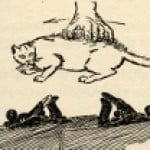Sharpening a Profile Cutter
Welcome! / Forums / General Woodworking Discussions / Tools and Tool Maintenance/Restoration / Sharpening a Profile Cutter
- This topic has 9 replies, 3 voices, and was last updated 11 years ago by
 Rob Young.
Rob Young.
-
AuthorPosts
-
 24 March 2013 at 9:54 pm #9776
24 March 2013 at 9:54 pm #9776I recently acquired a wooden ¼” center beading plane. The plane body and boxwood inserts are in good shape, as it the plane iron. I need some advice on how to sharpen the iron, without compromising the shape.
I assume I should flatten and polish the back, just as any other iron. I thought about slip stones for the profile, but I’m concerned I could alter the shape. Another thought I had was to wrap some 1200 or 2000 wet/dry sandpaper around a small dowel, say 3/16”, and while keeping the iron in the plane body, dragging it backwards to hone the beveled edge. I could polish the profile the same way, by charging a piece of dowel with polishing compound.
Am I on the right track here, or is there a recommendation you could give me? This is the first wooden profile plane I have bought, so I’m in new territory here.

TLN’s video is emphasizing the cutters used in a scraping plane. These are typically sharpened by creating a dead square edge around the profile.
The original poster is asking about a plane with a bedded iron so it has a profiled bevel.
As this is a beading plane, it is pretty easy to sharpen and even restore a damaged blade, short of severe damage to the quirk cutting portion.
Using an appropriately sized dowel wrapped in grits of sandpaper is a good start. Glue on the sandpaper so you can then put the dowel in a vice. Angle the dowel so that you match the bevel and thus hold the iron dead horizontal or dead vertical during the sharpening and honing. This works well for an iron that has been damaged. Once you restore the bevel shape (check it against the shape of the plane sole) you can stick with honing.
You can free-hand hone using slip stones (black Arkansas ones are good and not terribly expensive, just don’t drop it). Or you can take the blade after using your highest grit of wet-dry (1,000 or 1,500 maybe) and use the plane to create a profile in some hard wood. Pick good clear grain and work the right direction. Go slow and take light cuts. You now have an exact shaped hone. Rub on your green compound crayon, remove the iron from the plane and draw it back across the profiled hone (at the right angle of course).
Polish off the back again and enjoy.


And Ken is gonna love this…
As you have a center beading plane, you need to sharpen/hone the two quirk portions too. But those you do just like any other straight blade.
Also, if your bead is 1/4″ then use a 1/4″ dowel to start. The paper thickness won’t make enough difference. If you look at your blade square on, the curve is an ellipse. As you slowly tilt over to its bevel angle (30 to 35 degrees usually) it will become the 1/4″ circle.
And finally, all of this work on the bevel is done with the iron OUT of the plane body. You really don’t want to modify the shape of the plane sole unless it has become damaged. A nifty trick that wooden molding planes do is burnish the surface because the sole matches the profile of the iron.
 26 March 2013 at 10:20 pm #10070
26 March 2013 at 10:20 pm #10070Thanks so much Rob. At least my thinking was in the right neighborhood.
-
AuthorPosts
- You must be logged in to reply to this topic.
